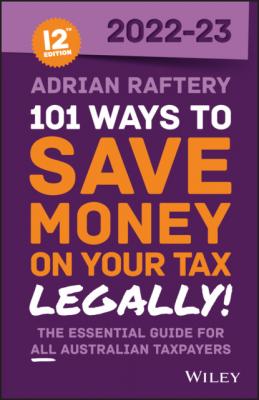101 Ways to Save Money on Your Tax - Legally! 2022-2023. Adrian Raftery
Чтение книги онлайн.
Читать онлайн книгу 101 Ways to Save Money on Your Tax - Legally! 2022-2023 - Adrian Raftery страница 12

To be eligible you must have worked at least 330 hours across 10 of the 13 months prior to the birth of your child, but your annual salary must also be less than $151 350. You can be eligible if you work full time, part time, casually, seasonally, on contract or in a family business. You cannot be working or receiving paid leave during the period of claiming the dad and partner pay.
In addition to dad and partner pay, families may be eligible for other family assistance such as paid parental leave and the Family Tax Benefit.
The 2022-23 federal budget has proposed that the 18 weeks of paid primary carer leave and the two weeks of dad and partner pay will be combined into an entitlement of 20 weeks of paid parental leave that can be divided between parents as they choose by 1 March 2023.
Claims must be lodged by the partner who is eligible to receive the payment. You can claim the dad and partner pay up to three months in advance or within a year following your child's birth or adoption. Employers are not required to pay this entitlement as it is solely administered and paid by Services Australia.
6 CHILD CARE
Ask the parents of any young child and they will tell you that their biggest expense is child care. If you have a child who is attending child care services approved by, or registered with, the government you may be eligible for the Child Care Subsidy (CCS). You can apply for the benefit at the Family Assistance Office. The amount you receive will depend on the type and amount of care that you use, your income, the reason you are using care and the number of children that you have in care.
If you have identified that you were eligible for the Child Care Subsidy in previous financial years, but have not received it, you can lodge a lump-sum claim with the Family Assistance Office. You must do this within two years of the end of the financial year for which you are claiming.
As can be seen in table 1.3, families with combined adjusted taxable incomes under $70 016 will receive a Child Care Subsidy rate of 85 per cent of the hourly cap depending on the type of child care you use (shown in table 1.4), reducing to 20 per cent for those families with incomes over $344 305 with no subsidy for family incomes over $354 304. The annual cap on the maximum amount of the subsidy that families could receive was abolished since the commencement of the 2021–22 financial year.
TABLE 1.3: child care subsidy rates (2021–22)
Source: Services Australia https://www.servicesaustralia.gov.au/your-income-can-affect- child-care-subsidy?context=41186
| Combined family income | Subsidy rate (up to hourly rate cap) |
|---|---|
| 0–$70 015 | 85% |
| $70 016–$175 015 | 50%–85% (reducing 1% every $3000) |
| $175 016–$254 304 | 50% |
| $254 305–$344 304 | 20%–50% (reducing 1% every $3000) |
| $344 305–$354 304 | 20% |
| $354 305 and over | 0% |
Since 7 March 2022 the child care subsidy has increased by 30 per cent to a maximum of 95 per cent for the second and subsequent children in child care with no annual cap.
TABLE 1.4: child care hourly rate caps (2021–22)
Source: Services Australia https://www.servicesaustralia.gov.au/type-child-care-you-use-can-affect-child-care-subsidy?context=41186#hourlyrate
| Type of child care | Hourly rate cap |
|---|---|
| Centre-based day care | $12.31 per child |
| Family day care | $11.40 per child |
| After hours school care | $10.77 per child |
| In-home care | $33.47 per family |
Given the complexity of the subsidy calculations that flow from tables 1.3 and 1.4 combined with fluctuating incomes, to reduce the risk of overpayment, Services Australia withholds 5 per cent of your child care subsidy upfront. When you submit your annual tax return, the Department will finalise the annual child care subsidy that was entitled to your family and pay any outstanding amount due to you.
According to Services Australia, you may be eligible to claim the Child Care Subsidy if you:
had a child 13 or under and not attending secondary school
passed the work/training/study test
ensure that your children under seven either meet the Government's immunisation requirements or have an exemption
used approved child care such as long day care, family day care, in-home care, outside school hours care, vacation care and/or some occasional care services.
Parents can claim up to 100 hours of CCS per child per fortnight dependent on passing a work/training/study test. Once eligible, the rebate is paid weekly or fortnightly by Services Australia based on child care attendance information it receives electronically from your service provider. Even if your child is absent from child care, the Child Care Subsidy can still be paid in some situations. You can receive payments for up to 42 absences per financial year, if you are charged for child care. These absent days can be taken for any reason with no evidence required.